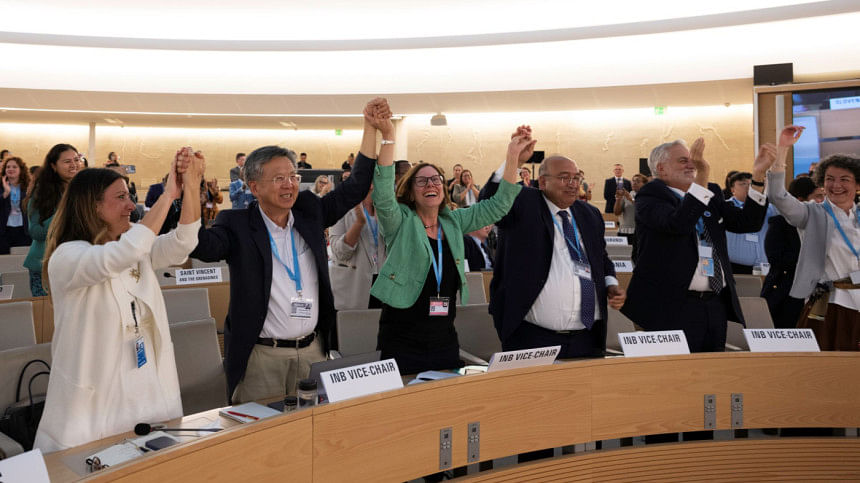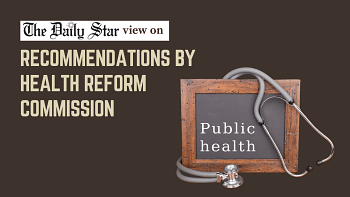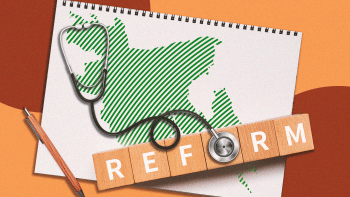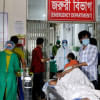Why the WHO Pandemic Agreement matters for Bangladesh

In May this year, member-states of World Health Organization adopted the WHO Pandemic Agreement following three years of intensive negotiations. Signed by 124 countries, including Bangladesh, this agreement marks a major shift in how the world prepares for and responds to future health crises. It aims to move from a fragmented, reactionary approach to one of coordinated resilience. For Bangladesh, a country burdened with emerging diseases and growing climate vulnerabilities, the agreement presents both an opportunity and a challenge.
The COVID pandemic exposed the stark inequities in global health. Vaccines, treatments, diagnostics, oxygen, and personal protective equipment were hoarded by high-income countries, leaving low- and middle-income countries (LMICs) struggling for access. Bangladesh, like many LMICs, waited months to secure vaccine doses. By the time many people in Dhaka and rural districts received their first shot, booster campaigns were already underway in wealthier nations. This inequity was not only unjust—it was dangerous. As long as one part of the world remains vulnerable, no country is truly safe.
The new pandemic agreement seeks to address these failures. One of its most important provisions is the establishment of a Pathogen Access and Benefit-Sharing (PABS) system. Under PABS, countries detecting new pathogens are required to share samples and data promptly. In return, they are guaranteed equitable access to vaccines, diagnostics, and treatments developed from those samples. For Bangladesh, which has long provided vital disease surveillance data on cholera, Nipah virus, and avian influenza, this represents long-overdue recognition of the value LMICs contribute to global health. PABS also requires pharmaceutical companies to reserve 20 percent of pandemic-related products for global distribution, half as donations and half at affordable prices, through WHO-coordinated channels. This mechanism aims to prevent the kind of vaccine apartheid witnessed during COVID. However, the PABS framework remains incomplete, with key details still under negotiation. In the absence of a binding legal structure, Bangladesh and other LMICs must remain vigilant in pushing for enforceable commitments.
The agreement also emphasises the need to strengthen national health systems. Articles 6 and 7 of the agreement call for investment in primary healthcare, laboratories, workforce training, and mental health support. In Bangladesh, where progress has been made but rural facilities remain under-resourced and urban hospitals overburdened, this serves as a critical call to action. A particular priority is the creation of a coordinated and comprehensive disease monitoring system. Current surveillance mechanisms are fragmented, with limited integration between laboratories, clinical settings, and public health agencies. Enhanced local laboratory capacity, streamlined reporting systems, and investment in trained field-level personnel are essential for achieving early detection and rapid response.
Workforce protection is another cornerstone of the agreement. During COVID, Bangladesh's frontline healthcare workers—many of whom were women—faced extreme pressure with minimal protection. Many suffered from burnout and infection. The pandemic agreement calls for safer working conditions, gender-responsive policies, and fair compensation. Bangladesh can lead by example by investing in improved working conditions and professional development for its health workforce.
Another notable component is the push to decentralise manufacturing capacity. The agreement's articles 10 and 11 promote technology transfer to LMICs to enable local production of vaccines and diagnostics. This is highly relevant for Bangladesh, which has already demonstrated capacity in manufacturing generic medicines and vaccines. By leveraging its existing pharmaceutical infrastructure and implementing supportive policies, Bangladesh could emerge as a regional hub for pandemic countermeasures. Encouragingly, initiatives like the WHO mRNA vaccine technology transfer hub in South Africa, along with facilities in Rwanda and Senegal, illustrate what is possible. Bangladesh should advocate for similar partnerships, not only to serve domestic needs but also to support the broader South Asian region.
A major highlight of the agreement is its commitment to equitable research and development (R&D). Article 9 challenges the prevailing model in which LMICs serve as data sources but are excluded from authorship, leadership, or access to resulting products. The agreement promotes open science, fair collaboration, and transparency in clinical trials. For Bangladeshi researchers, this offers a pathway to greater recognition and influence in global health research. However, it will require local investment in research institutions and training programmes. Building robust, transdisciplinary research frameworks that connect epidemiology, clinical medicine, and laboratory science is essential. Bangladesh must move beyond siloed data collection and foster networks that integrate field surveillance, clinical data, and diagnostics into a cohesive platform.
The agreement also endorses the "One Health" approach, which integrates human, animal, and environmental health. With its dense population, livestock farming, and climate-sensitive ecosystems, Bangladesh is particularly vulnerable to zoonotic spillovers. Coordinated action across ministries and investment in veterinary and environmental health infrastructure are urgently needed. The agreement's focus on integrated early warning systems and cross-sectoral collaboration aligns well with national needs. This must be paired with decisive national leadership. At present, multiple institutions—including the Directorate General of Health Services (DGHS), the Institute of Epidemiology, Disease Control and Research (IEDCR), and the Centres for Disease Control and Prevention (CDC)—share overlapping responsibilities, leading to delays in data sharing and coordination. Designating a central authority—whether the DGHS, IEDCR, CDC, or the Prime Minister's Office—would improve coordination, reduce redundancies, and support timely, evidence-based responses.
A further critical feature is the financial mechanism outlined in Article 18, which proposes the creation of a coordinating financial mechanism to support pandemic preparedness, especially in resource-limited settings. Bangladesh, which has historically benefited from international development assistance, can leverage this platform to fund laboratory upgrades, workforce training, and surveillance networks. However, donor fatigue and recent funding cuts—particularly from the US—highlight the importance of domestic co-financing and regional cooperation.
Of course, the agreement is not without criticism. Many of its provisions are voluntary, and enforcement mechanisms are weak. Nevertheless, it marks a vital shift: from treating pandemics as isolated emergencies to recognising them as systemic risks that demand ongoing, collective investment. It signals the beginning of a more equitable model of global health governance.
For Bangladesh, the road ahead is clear. The country must strengthen its health infrastructure (particularly in rural and underserved areas), invest in local R&D and manufacturing capacity, advocate for enforceable global commitments under the PABS framework, integrate One Health across government institutions, ensure protection and empowerment of its health workforce, and promote regional cooperation in South Asia. Most importantly, it must establish a resilient, integrated disease surveillance system, staffed by trained professionals and guided by empowered leadership.
As the world shifts from reaction to resilience, Bangladesh must not simply follow—it must lead. The memories of COVID and the lives lost demand more than statements and signatures. They demand action. The pandemic agreement provides the compass to navigate this path.
Dr Md Zakiul Hassan is associate scientist at icddr,b and DPhil fellow, Moh Foundation fellow, and Clarendon scholar at the Pandemic Sciences Institute, University of Oxford, UK.
Dr Md Mustafizur Rahman is senior scientist and senior director of the Infectious Diseases Division at icddr,b.
Views expressed in this article are the authors' own.
Follow The Daily Star Opinion on Facebook for the latest opinions, commentaries and analyses by experts and professionals. To contribute your article or letter to The Daily Star Opinion, see our guidelines for submission.

 For all latest news, follow The Daily Star's Google News channel.
For all latest news, follow The Daily Star's Google News channel. 











Comments